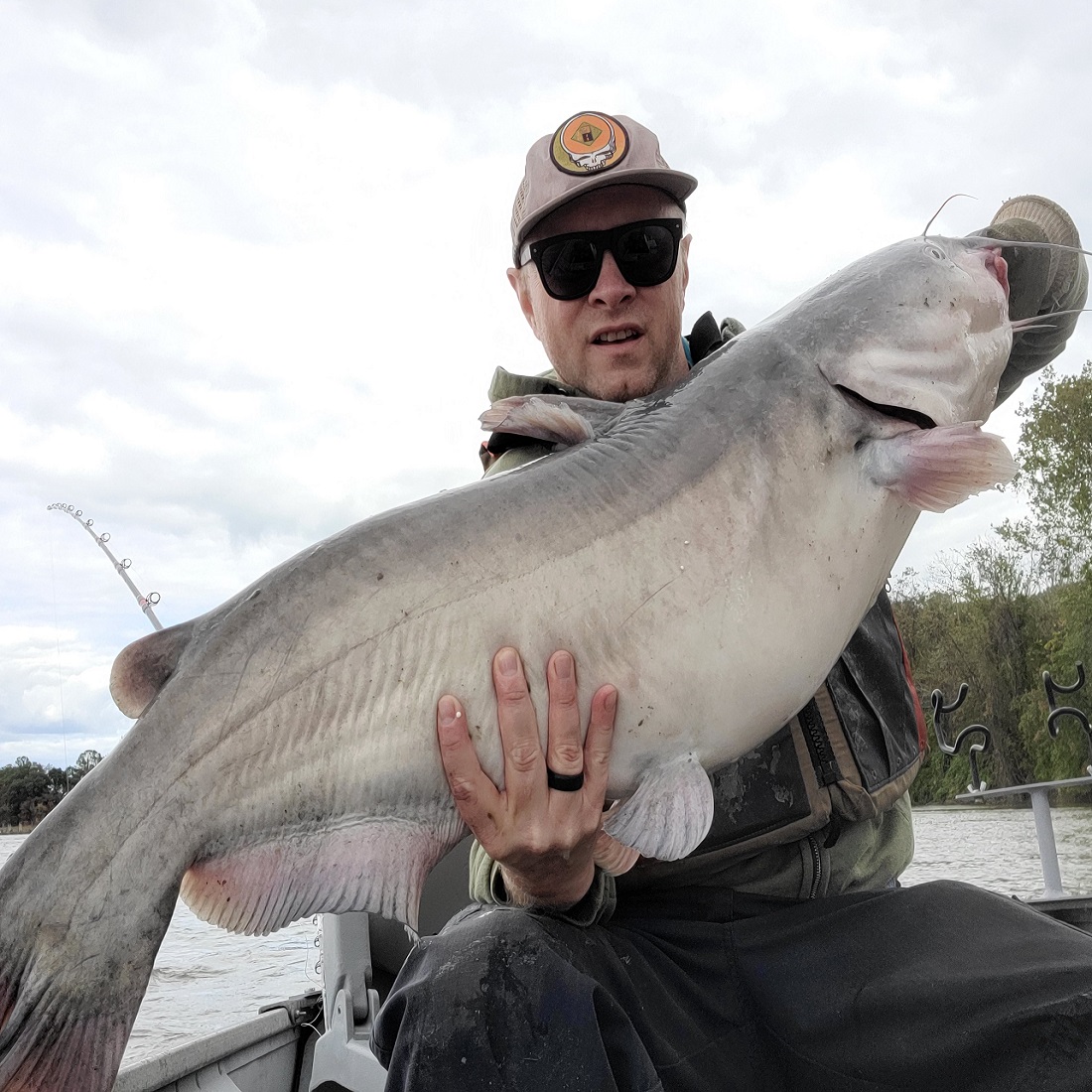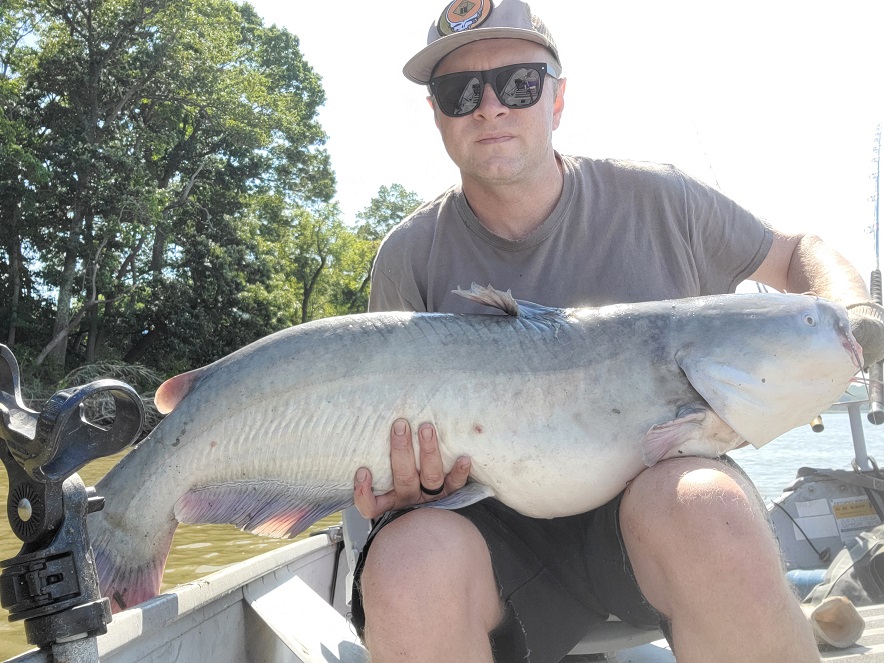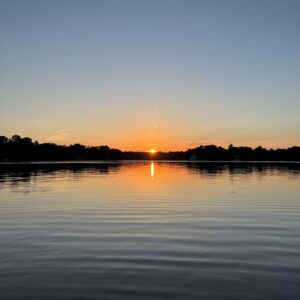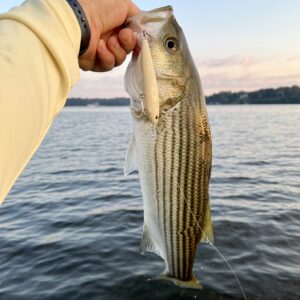Introduced to the Chesapeake Bay in the 1970s, blue catfish have exploded throughout the watershed, concerning biologists but exciting anglers
By James Houck
Huge, gnarly, voracious, and here to stay. The blue catfish isn’t sexy. But as an apex species, big blue is attracting an increasing number of anglers throughout the Chesapeake Bay region for a variety of reasons: they’re brute fighters, excellent table fare, and invasive. So much so, that not harvesting them should be illegal. But, perhaps, the most compelling reason why anglers are targeting blue catfish—from Virginia’s lower Bay rivers to the Chesapeake’s Maryland headwaters at Susquehanna—is the opportunity to crush your personal best time and again with this leviathan fish. Catch a 10 or 15 pounder, then a 20. That’s a good tug. Still not satisfied? Your next bite could be a 30 pounder, and tomorrow’s…40-plus.
State records in the Chesapeake watershed can, potentially, be one-upped with every outing. Delaware’s blue catfish state-record was shattered twice this past September alone; first, with a 48-pounder, then a 53. Maryland’s state-record stands at 84 pounds and Virginia’s is a whopping 143-pounder, also the IGFA’s all-tackle world record. These fish feed hard and get big. And they’re affecting the entire ecosystem. Biologists are already on the case; and now, recreational anglers are catching on.
Everywhere and Nowhere
Crisp. Cold. Near freezing, but approaching a more comfortable 40 Fahrenheit. It’s an early-November morning, just a few days removed from Halloween, and the sun is peeking over mum-colored tree tops along the north-eastern bank of the Severn River in Annapolis, Maryland. The sunrise is a good one, with burnt orange hues bleeding into an opal sky. Cross river sits the United States Naval Academy—its stately, ivory buildings of Maine granite glistening with the day’s first light streaming across their facades.
I’m dead-drifting in the water, but have this amazing view and about to give something a try.
Sitting in a slim river-running vessel—a ’78 McKee Craft side console—I’ve taken a break from dawn striper fishing to try my luck at landing a blue cat. With the sun inching a finger above the horizon, then quickly two, three, four, it’s a good time to put down the topwater rig and give a couple cat outfits a run. The blue cats are everywhere I’m told, and landing one should be a cinch. The autumn reports from anglers region-wide suggest they are feeding with abandon.
The two medium-heavy powered rods I’ve employed for this get-go are matched to 3500 class spinning reels and heavy 60-pound-test Carolina rigs on the business end. Stout 7/0 circle hooks are holding two baits of choice—classic cherry Kool-aid and garlic-marinated gizzards on one; cut bunker on the other. From butt to bait, the rigs are strong enough to handle blues up to twenty pounds, I figure. Anything larger and things could get dicey.
There’s a three knot puff gently nudging the McKee into what’s probably the deepest water of the entire Severn; a near-50-foot hole that I’m hoping harbors a few fish. But after two hours of changing the bottom-dwelling baits every 15–20 minutes and repositioning the boat several times, this outing proves a dud. Turns out, the blue cats are nowhere. Not in this stretch. Not at this moment, at least. My luck would have to wait.
Meanwhile, 15 other small crafts located about 46 miles from me, as the crow flies, were hauling in more than 400 pounds of blue cats and celebrating. In a nowhere-ville, out-of-the-way, quiet stretch of tributary, an invasive species tournament was nearing completion at the tiny Federalsburg Marina. And the fish were everywhere.
Located along Marshyhope Creek, deep within Maryland’s rural Eastern Shore, the Town of Federalsburg (population 2,842) hosted the 2nd Annual Madness on the Marshyhope Invasive Catfish Tournament & Food Festival. The tournament is a partnership between the town and the Maryland Department of Natural Resources (DNR) to raise awareness of invasive species (including northern snakehead) and their ecological effect on the Marshyhope and all waters downstream.
While I was having a fruitless morning, the 50-plus registered anglers were catching a total of 198 blue cats, with the largest weighing 26.9 pounds. Almost 200 fish to my none. What in Sam Hill did I do wrong? Same day, same time. A different piece of water, but connected nonetheless through the intricate Chesapeake network.
Blue catfish are sometimes, seemingly nowhere. And yet, they are everywhere. Skinny, shallow Marshyhope Creek—a 15-mile offshoot of the Nanticoke River, of which their junction is another 20 miles from the Chesapeake Bay proper—has proven, with certainty, that blue catfish have spread exponentially throughout the entirety of the vast watershed.
The Opportunistic Generalist
In 1974, three-hundred thousand blue catfish were introduced to Virginia’s James and Rappahannock rivers by the Virginia Department of Wildlife Resources (DWR). American sporting was at a zenith and the department had an idea: offer anglers the opportunity to hook into a du jour species that had gained acclaim in the southern fisheries of Mississippi, Missouri, and the Ohio River basins. The plan was well-intended.
With the ever-popular striped bass’ population experiencing a steep decline, DWR wished to create a new, recreational trophy fishery. Through 1985 they stocked blue catfish in the state’s Chesapeake feeder rivers, finishing out the project in the York River system (which includes the Pomonkey and Mattaponi rivers). And the fish grew…very well. They adapted to the estuarine habitat and salinity levels of the Bay’s brackish tribs, which also provided a near-endless supply of forage from menhaden to mussels, stripers to American eels, and, even, the beloved blue crab.
In the nearly-50 years since their introduction to this non-native environment, blue catfish have spread into the Chesapeake’s middle and upper rivers, most notably the Potomac, Patuxent, Nanticoke, Choptank, Magothy, Patapsco, Middle, and Susquehanna. And alarm bells are ringing.
Now, this species explosion is a concern, as scientists, anglers, commercial watermen, and politicians study and grapple with the impact the species is having on the Chesapeake ecosystem. So much so that last March, newly-minted Maryland Governor Wes Moore called on the federal government to declare the expanding population of blue catfish (and other invasives) to be an ongoing commercial fishery disaster in Maryland’s portion of the Bay. “It is critical to act now to mitigate the effects of the invasive species and to provide assistance to the commercial fishing industry,” he wrote in a letter to U.S. Commerce Secretary Gina Raimondo, requesting the declaration under provisions of the Magnuson-Stevens Fishery Conservation and Management Act and the Interjurisdictional Fisheries Act.
The story of the blue catfish, it seems, turned from one of “happy fish, happy angler” to “invasive threat.”
Branson Williams is a biologist with Maryland’s DNR and serves as the state’s first Invasive Fishes Program Manager. His role—help control the most out-of-control species. No easy task, but pretty good job security.
“At this point, eradication of blue catfish in the Chesapeake Bay watershed isn’t a realistic goal,” Williams says.
“The blue catfish is an opportunistic, generalist species,” he explains. “They do well in a variety of habitats, especially large, eutrophic tributaries like those in Chesapeake Bay and can survive in salinities from zero to over 15 parts per thousand. The fish feeds on a wide variety of prey items. I’ve even seen things like chicken bones and electronics in their stomachs. Their large body size limits predation once the fish is mature, and they can live for up to 20 to 30 years. The large body size allows females to produce eggs and males actively defend their nests and fry. It’s easy to see how blue catfish are successful as a species.”

From 2019 to 2021, DNR teamed with the U.S. Geological Survey to study blue catfish in the Patuxent River. What they discovered about the intrusiveness of the species and their potential impact on others was revealing. The scientists estimated that upwards of 70,000 fish inhabited a five-mile stretch of the river, with high concentrations in the Jug Bay vicinity. It amounted to a whopping 1,250 blue cats per acre. And the stomach contents of the 2,172 fish examined? Mostly white perch, American eels, gizzard shad, crabs, and other small fish.
“American eel is a species whose abundance is in decline in the region, so blue catfish eating so many of them is cause for concern,” Williams says. “It seems the fish also prefer small crabs and their predation on juvenile blue crabs may be significant. When you consider the number of fish present in the system, a lot of blue crabs are being eaten. The potential impact to our ecosystems and fisheries is very real.”
While Gov. Moore awaits word from the Feds about the disaster-relief funding to help mitigate the spread of invasives (no update at the time of writing), the State has already initiated programs and promotions to increase the commercial harvest, recreational angling, and culinary interest of blue catfish. Virginia has, too.
The Maryland Department of Agriculture’s Seafood Marketing Program, University of Maryland, and Virginia Institute of Marine Sciences, among many other state departments, federal agencies, and educational institutions, have aggressively promoted the fish to the restaurant industry, grocers, watermen, anglers, and home gourmands. By regularly hosting educational symposiums, cooking demonstrations, like Gov. Moore’s Buy Local Cookout, and having a presence at local events, such as the Maryland Seafood Festival, the effort seems to be having an effect.
“We had a creel survey on Potomac River, designed for bass, but we collected data on angler catches of catfish,” explains DNR’s Recreational Fisheries Outreach Coordinator Erik Zlokovitz. “There, we saw an increase of about three catfish caught per five hour day in 2017 to six per five hour day in 2022; both of these [data sets] are much greater than that reported in the 1990s, at about one catfish per fishing day.”
Commercial landings have climbed, too. In 2022, about 3.6 million pounds of blue catfish were harvested, up from 2.8 million in 2021. And the fish increasingly is showing up in menus and grocer cases across the region.
“The fish tastes great and is safe to eat,” Williams notes. “These aren’t the bottom feeder catfish that people are used to eating. They provide an incredibly mild, white, flaky filet that can be prepared in many different ways. It’s a healthy meal that can be enjoyed by the whole family, and every fish you take from the water helps the bay watershed.”
Catch and cook oh là là.
Ultimately restoring the species’ reputation to one of worthy pursuit, good eats, and, quite simply, fun as heck to catch, could be the salve to this worsening eco-wound.
In By the Jaw
Angler Shane Henry is on board. In fact, he’s downright addicted to catching Patuxent beasts. A southern Illinois transplant to Maryland, Henry says he cut his teeth fishing for channel cats and flatheads in Rend Lake in the ’90s and 2000s. His passion for large catfish grew when he began expanding his angling range to the Mississippi River, Big Muddy River, and other lakes, like Baldwin Lake.
Having joined the Navy, though, Henry would find himself in far-flung locales, some lacking decent fisheries to target. Then his assignment papers sent him to Maryland.
“I live in Maryland now and blues are the predominant species of catfish,” he explains. “What makes them fun for me is that they are big and they are plentiful. This is, of course, striper country and the general attitude toward catfish is negative. But my thought is, ‘you have a good fishery here that many people in other parts of the country would love to have. Why not take advantage and have fun catching big fish?’”
Henry got after it, becoming very good at catching hefty blues by applying many of the lessons he had learned in the Prairie State to this year-round fishery. He breaks down seasonal differences:
“I fish all year. Each season has its own dynamics for how to target them. In spring, when the water [temperature] reaches the 60s [Fahrenheit], just before spawn is always great with fish feeding heavily and often shallow. Early summer when the water gets up to 75, the spawn hits and the bite slows down considerably as male fish are on their nests.
“After the spawn, in late-June or early-July, those post-spawn fish come out of the nest hungry and the action is on fire for about a month as the fish get their weight back and start to move into deeper holes and channels. Then the normal summer pattern will typically get you average five- to 10-pound fish on most trips, with some larger ones in the 20s and 30s here and there.
“Fall, when the water starts to get back down in the 60s, is the best time of year, I think. Fish are feeding heavily to prepare for winter and can be caught at all depths in good numbers. It seems the big ones are always easier to catch then. Winter can be slow with most trips only producing five or so fish, but the ones that are feeding are typically big.”
Beefy gear is employed. Medium-heavy or heavy rods that are 7-foot or 7’ 6”. Bait casting reels are preferred. Forty- to 50-pound-test main line; 80-pound-test leader. 7/0 to 10/0 circle hooks.
“Bigger hooks are better in warm weather,” Henry says. “Smaller hooks are better in winter paired with smaller baits. When anchored, I use a three-way rig with a crane swivel on my casted rigs, and a Carolina rig on vertical suspended rods. These rivers have some pretty heavy current, so I prefer to use eight- to 10-ounce weights.”
Then it’s a matter of baiting up. In the Chesapeake watershed, the best baits are gizzard shad and menhaden. The oiliest fish you can find, and the freshest possible. “I won’t use anything that’s over three days old,” Henry says.
The dynamics of the river will typically tell Henry what spots to target. “When you have a river with a current that changes direction every six hours, one spot that might produce on an outgoing tide can change on the incoming,” he explains. “You want to find ambush points where a fish can sit and not expend its energy. Channel ledges along outside bends are always good. Holes that make a drop of about five to 10 feet from the area upstream of it (remembering that upstream means something different every six hrs when the tide changes), creek mouths, wood structure. All of these things make a current break which is an ideal place for a fish to sit and wait for a baitfish to come by. At night in the summer, you can often catch fish on flats without structure in anywhere from five to 50 feet of water as long as that area doesn’t have too much current. Slack tides are short but have the same results. That’s when fish are on the move either actively hunting or heading to a different ambush point.”
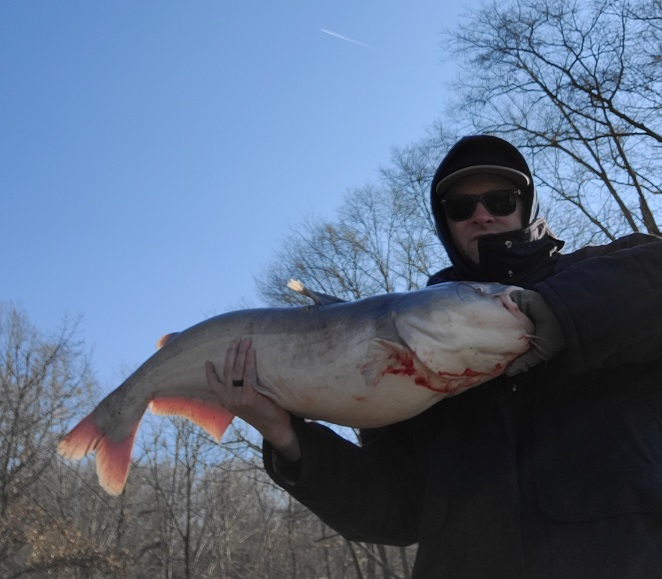
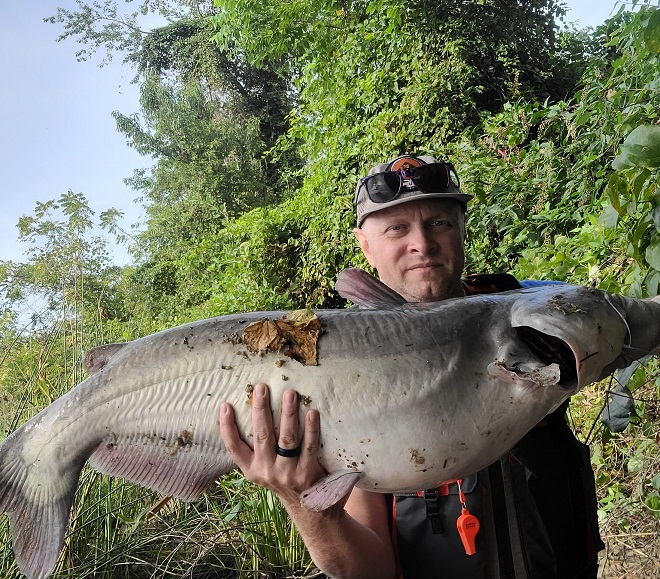
To date, Henry is still pursuing a fish that cracks the 40-pound mark in the Patuxent, having caught numerous fish in the 30-plus-pound range, one of which stood out:
“In August of ’22, I was fishing out of my kayak using vertically suspended rods while anchored. One rod got slammed and I realized I was fighting a pretty big fish against some heavy current. It was a back and forth battle for a while when suddenly a branch came downriver and got stuck on the side of my kayak. I had to put the rod back in the holder, and try to push off the branch with my paddle to keep the fish from getting tangled in it. I ended up unclipping the anchor and managed to push it away, but now I was drifting, fighting a fish, and the branch was still hitting my kayak. This turned into a cycle of picking up the rod, fighting the fish, putting the rod back, pushing the branch away with my paddle, over and over until I finally got the fish to me.
“Hauled it in by the jaw, turned the kayak around and realized I was all the way around the bend a quarter mile from my anchor rope. I use a pool noodle on the anchor rope for this very purpose. It’s meant to keep the rope afloat so you can retrieve it, but the current was so heavy that it still pulled that anchor rope under the surface. I couldn’t find it.
“The fish was too big to weigh and measure in the kayak, so I hit the bank for that. It was 33 pounds and 37 inches. I got a picture and headed back. The next weekend, I headed out again with a new anchor, rope, and all. As I came up to that same spot, there was my pool noodle and whole anchor rig from last week bobbing away on the surface. I pulled it up and it seemed heavier than before. It had someone else’s broken off rig and a hooked 10 pound blue wrapped around it!”
Though Henry has matched techniques to patterns that enable him to catch blue catfish consistently on the Patuxent, he acknowledges that the largest fish are in the Chesapeake’s more southern rivers.
“The Potomac is probably anyone’s best bet to catch a monster in Maryland,” he says. “My theory is that the rivers that flow down from the mountains into the tidal region are going to grow the biggest fish. There is something about that oxygenated mountain runoff water that seems to make them grow bigger and faster. You can see it in how the James River, Potomac, and Rappahanock are producing the biggest fish in the watershed. The Potomac has held the Maryland state record for many years, but I think that record isn’t going to last much longer.”
Cat Craze
Theories aside, there is little doubt that the rivers originally stocked with blue catfish, along with the Potomac, hold the largest specimens. And it’s why anglers are flocking to them in droves in hopes of hooking into the fish of a lifetime.
Bank fishing with two-, four-, six-rod setups has exploded in popularity and it’s easy to see why. A cursory search of Instagram and TikTok for #bluecatfish is loaded with video clips of anglers—such as Earnie Robinson (@ernie_the_hog_snatcher) and Everett Mathis (@alof_tv)—lining the banks of Washington, D.C., and pulling in huge cats time and again.
There’s also an increasing number of charter captains capitalizing on the blue cat craze. Some have been at this game for decades, while others are shifting from overfished species to blues. Captain John Garland is a legend on the James having guided for the big fish since 1990. Captain Mike Starrett is renowned on the Potomac, doing so for more than 30 years, too. Many more will make names for themselves in the years ahead.
Me…I’ll be happy when I hook into the species, large or small. I’ve got all winter to give it another shot…and spring, summer, fall. Whether a 10-pounder or 40-plus picks up the bait or not, the fun of angling for blue catfish is in the preparation of gear, honing techniques, and anticipation for a leviathan lurking below.

Editor’s Note: This article appears in the print edition of On The Water’s 2024 Angler’s Almanac and online at onthewater.com. Lead photograph courtesy Shane Henry, who holds a Patuxent River blue catfish.

